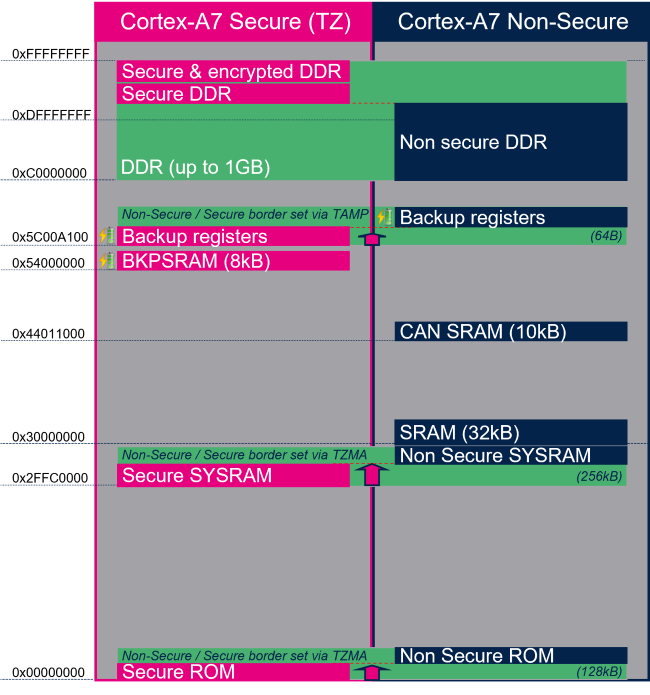1. Overview[edit source]
This article shows the default memory mapping defined by STMicroelectronics in STM32MPU Embedded Software. It uses a subset of all memory regions that are exposed at hardware level: customers may use other memory regions or aliases that are not shown here but are described in the STM32MP15 reference manuals.
2. Arm core characteristics[edit source]
The integration of Arm® Cortex® cores sets some constraints on the device memory mapping: the main ones are listed in this article.
2.1. Reset address[edit source]
Arm® Cortex® cores start running from address 0x00000000 on reset, which is why this address respectively points to:
- The ROM code on the Cortex-A7 side. This read-only memory embeds the boot code that is executed when the platform boots (and executes the boot chain) or wakes up from low power STANDBY mode.
3. Memory mapping[edit source]
3.1. Overall memory mapping[edit source]
The memory mapping below is a subset of all regions that are exposed at hardware level: it shows the default configuration used in OpenSTLinux but the customer may choose a different mapping to take advantage of other address ranges defined in STM32MP13 reference manuals.

4. Internal RAM mapping[edit source]
4.1. Overview[edit source]
SYSRAM and SRAM can be used by secure and non-secure Cortex-A7 contexts like described in SYSRAM internal memory and STM32MP13 SRAM internal memory articles.
4.2. How to do that in practice[edit source]
The memory usage is defined in both Cortex-A7 contexts:
- on secure Cortex-A7: in OP-TEE device tree, using Reserved_memory mechanism
- on non-secure Cortex-A7: in Linux device tree, using Reserved_memory mechanism
To ensure the consistency of the system, both memory declarations have to be updated according to the expected configuration.
4.2.1. SRAM[edit source]
By default part of the SRAM is reserved for DMA chaining for Linux features. It can be freed for some other purposes by removing following:
- Linux device tree
- Remove followings declarations:
&sram {
dma_pool: dma_pool@0 {
reg = <0x0 0x4000>;
pool;
};
&dma1 {
sram = <&dma_pool>;
};
&dma2 {
sram = <&dma_pool>;
};